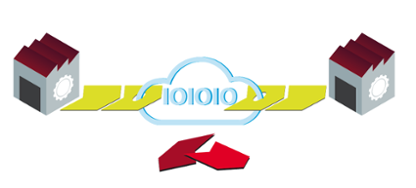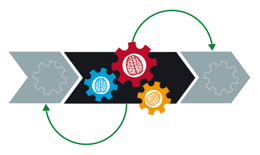What Is Postmodern ERP?
Brian Hoey - November 12, 2019

 It’s a story one hears surprisingly frequently: a mid-sized enterprise company adopts a new mega-ERP solution, and they’re almost immediately mired in constant disruptions. Of course, changing out your entire IT infrastructure all at once (instead of piecemeal) is bound to cause some short-term disruption, especially if the process is long overdue—but that doesn’t account for all of the late or missed orders, the expensive IT support requirements, and other issues that we see in these scenarios.
It’s a story one hears surprisingly frequently: a mid-sized enterprise company adopts a new mega-ERP solution, and they’re almost immediately mired in constant disruptions. Of course, changing out your entire IT infrastructure all at once (instead of piecemeal) is bound to cause some short-term disruption, especially if the process is long overdue—but that doesn’t account for all of the late or missed orders, the expensive IT support requirements, and other issues that we see in these scenarios.
What does account for all of the trials and tribulations is the lack of flexibility that many companies find when they adopt the kind of big, totalizing IT systems that these mega-ERPs usually comprise. Previously, individual teams would have built up in-unit expertise for dealing with their particular IT challenges and the business needs with which they intersect. When businesses adopt these huge ERP systems all at once, they reduce the presence of shadow IT and information silos—but they do so at the cost of all of this accumulated knowledge, and the intra-unit flexibility and efficiency that it implies.
We’ve seen how this plays out time and again, and yet, businesses keep adopting for the kind of modern ERP approach that we’ve been discussing, perhaps because they’re not sufficiently familiar with the alternative: Postmodern ERP.
Postmodern ERP: What Is It?
At a very high level, Postmodern ERP is a philosophy for creating a flexible IT infrastructure, in which different pieces of technology are adopted on their own merits and then networked intelligently with one another to promote connectivity. As Gartner points out, this can be applied to administrative ERP strategies and operational ERP strategies—with the latter being perhaps more relevant to manufacturers, shippers, freight forwarders, and other businesses that are dealing with a lot of complex moving parts.
In a manufacturing context, for instance, your order management team might try out a few different technology solutions for tracking customer orders and generating bills-of-materials for each one, ultimately adopting the one that they like best. Meanwhile, the inventory manager chooses a different system for live inventory monitoring that collects real-time data from smart pallets and other sensors throughout the warehouse. In the past, these two disparate solutions might have led to information silos, which could in turn create disconnect between these two functions and, inevitably, production delays. In a Postmodern ERP environment, these solutions would be connected via a small, central ERP solution so as to remain interoperable with one another.
Challenges in ERP Implementation
In the opening paragraphs, we gave a brief account of how a company’s ERP system can help or hurt operations, but let’s take a slightly closer look at the particular ERP challenges that make Postmodern ERP necessary. Fundamentally, your company’s choice of ERP strategy will always be a balancing act between competing sources of value. On the one hand, a “best-of-breed” approach in which every team chooses the top performing IT solution for their particular function offers each individual business unit the chance to maximize the functionality of their software. Your production planners would adopt the system that bests maximizes throughput and minimizes disruptions, while the team in charge of invoicing for customer orders would use something unrelated. This presents obvious value for the individual teams, but increases the likelihood of silos cropping up even between related business functions.
With a modern ERP setup, on the other hand, you reduce the possibility of silos and disconnect at the expense of the particular and unique needs of each team. Everyone adopts the same software solution all at once, and they all figure out how to maximize its value for their particular tasks. Often, if a users find that they can’t perform a particular action (say, visualize relevant KPIs relating to a production run), they’ll find another piece of software that will enable them to do so—and they’ll often implement it without explicit stakeholder approval, resulting in shadow IT. The result is, again, disruptions and disconnect—exactly the things that an overarching ERP system is meant to stave off.
Postmodern ERP vs. Best-of-Breed
The challenges above should strongly suggest the need for a third path that synthesizes these two old-school ERP strategies. You want functionality, but you shouldn’t sacrifice too much cohesion to achieve it. Likewise, you want a shared infrastructure for visualizing data and making decisions, but you don’t want to hamstring your individual teams with restrictive IT parameters. Thus, Postmodern ERP.
It’s here that some businesses fall under the misapprehension that Postmodern ERP and best-of-breed are essentially the same thing. The crucial difference between the two is that in Postmodern ERP there’s a strong emphasis placed on interconnectivity and interoperability—an emphasis that isn’t traditionally part of best-of-breed strategies. Rather than each function choosing its software solutions independently, teams seek out solutions that will scale easily and integrate efficiently with existing systems. This means that, while you might make a tradeoff between functionality and connectivity, the contrast is much less stark.
How Does Postmodern ERP Add Value?
Okay, we’ve seen some of the potential pitfalls of traditional ways of implementing ERP software—pitfalls that Postmodern ERP helps businesses to avoid—but how does Postmodern ERP add positive value in its own right? To begin with, there are a handful of ways:
- Increased collaboration across the entire product lifecycle
- Opportunities for supplier and client integration
- Improved usability
- Reduced needs for specialized IT knowledge (and thus lower support costs)
- Increased flexibility
- Reduced need for large scale IT migrations
These aren’t the only ways in which this technique can help to smooth out the value chain for manufacturers and other complex businesses, but they should offer a good suggestion of the ways that this strategy can impact a particular organization. Ultimately, a Postmodern ERP mindset is less about the particulars of the software you’re adopting and more about the values your company wants to live by—representing an agile, flexible, and modern mindset that can help businesses to become proactive, rather than reactive, when addressing changing business needs and market conditions.
LATEST POSTS
- Understand Circular Economy in The Manufacturing Industry
- How Can Industry 4.0 IT Integration Be Achieved Smoothly?
- The Significance of Order Sequencing in Discrete Manufacturing
- How to improve your Supply Chain Management: The Power of Control Towers
- Optimizing Human Resource Scheduling in Manufacturing: A Technological Approach



